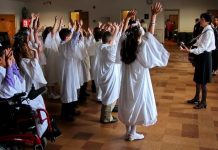
by Cullen Schippe
One of my favorite Gospel narratives is the story of Jesus’ transfiguration (Mark 9:2-8). You will hear it on the second Sunday of Lent. I used to think it quite interesting that a Gospel passage that seems so connected to the glory of Easter would be proclaimed early in Lent.
The transfiguration was like a media event for the three disciples. It was a first-class vision, a dazzling display, and a supernatural glimpse at the divinity of Jesus. Appearing with Jesus in this narrative are two pivotal figures in the history of salvation—Moses the liberator and Elijah, one of Yahweh’s spokespersons. The vision is accompanied by a simple command from the cloud. “This is my beloved Son. Listen to him” (Mark 9:7).
It isn’t the vision itself, however, that is for me a key to the Lenten celebration. That key lies in what happens next. First, is the reaction of Peter who wants to put up some tents and to remain in this moment of reassuring wonder. In his fear and confusion, the rest of the world disappears and his only focus is on the vision.
Yet in an instant the vision fades away, and down the mountain go the disciples. On that journey down the mountain, Jesus charges them not even to speak of the event until he has risen from the dead. That charge unleashes a whole raft of questions for the little band. Then at the base of Mount Tabor, the real journey begins—a journey that will lead to Jerusalem and to the cross and ultimately to the empty tomb.
As catechists during Lent, our focus ought not to be on a moment of blazing certainty and promise. Our focus instead is on a world full of questions. We are fellow pilgrims with those we teach, and our journey is headed through a plain of suffering and doubt that is also laced with hope and expectation.
Lent is not an oasis or a retreat from the world. Lent calls us to rush headlong down the mountain to witness to what we have seen and to ask all the questions that we find in our hearts. Questions are not enemies. The disciples’ questions led them gradually to understand that the Son of Man had to suffer. Their questions caused them to drop everything and follow in Jesus’ footsteps. The disciples’ questions led them to spend their lives in the service of others—the hungry, the naked, the poor, the imprisoned, the sick, and the outcast.
All that could be a reason to hear this Gospel early in Lent—to help us unlock the season’s mysteries. Our catechetical Lent could well be a reflection of the words of the poet Rainer Maria Rilke: “Be patient toward all that is unsolved in your heart and try to love the questions themselves, like locked rooms and like books that are now written in a very foreign tongue. Do not now seek the answers, which cannot be given you because you would not be able to live them. And the point is, to live everything. Live the questions now. Perhaps you will then gradually, without noticing it, live along some distant day into the answer.”
That “distant day” will be our Easter Vigil. The vigil’s fire will sear away our doubt. Its light will show us the way. Its water will wash away our selfishness and bind us to the community. Its broken bread and shared cup will nourish us for the rest of life’s journey.
As catechists we can be too quick to provide answers—too quick to set up tents on Mount Tabor. We are anxious to tell others what we have seen on the mountaintop. So anxious, in fact, that we sometimes seem to preempt the action of the Holy Spirit.
The essential catechesis for Lent is nestled in two very simple sentences that flow from the overshadowing cloud of this most wondrous and necessary of liturgical seasons. “This is my beloved Son. Listen to Him.”
Cullen Schippe has been in Catholic publishing for well over 40 years and currently serves as President and Publisher for the Peter Li Education Group. Email Cullen at cschippe@peterli.com.
Copyright 2015, Bayard, Inc. All rights reserved. This article is protected by United States copyright and other intellectual property laws and may not be reproduced, rewritten, distributed, redisseminated, transmitted, displayed, published or broadcast, directly or indirectly, in any medium without the prior written permission of Bayard, Inc.
This article was written by the Catechist Staff and appeared in Catechist magazine, May 2015
Image Credit: Shutter Stock 2510744




